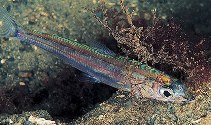Add your observation in Fish Watcher
| Native range | All suitable habitat | Point map | Year 2050 |

|
| This map was computer-generated and has not yet been reviewed. |
| Argentina sphyraena AquaMaps Data sources: GBIF OBIS |
Upload your photos and videos
Pictures | Google imageArgentina sphyraena
Picture by Svensen, E.
Pictures | Google imageArgentina sphyraena
Picture by Svensen, E.
Common names from other countries
Classification / Names आम नाम | उपशब्द | Catalog of Fishes(वर्ग, प्रजाति) | ITIS | CoL | WoRMS | Cloffa
> Argentiniformes (Marine smelts) > Argentinidae (Argentines or herring smelts)
Etymology: Argentina: Latin, argentus = silver (Ref. 45335).
More on author: Linnaeus.
Etymology: Argentina: Latin, argentus = silver (Ref. 45335).
More on author: Linnaeus.
Environment: milieu / climate zone / depth range / distribution range पारिस्थितिकी
समुद्री बाथीड़िमरसल; गहराई सीमा 50 - 700 m (Ref. 56504). Deep-water; 71°N - 24°N, 19°W - 36°E
वितरण देश | ऐफ ऐ ओ क्षेत्र | Ecosystems | संयोग | Point map | भूमिका | Faunafri
Eastern Atlantic: northern Norway to Western Sahara including southern Iceland, Faroe Islands, Shetlands and Mediterranean.
आकार / वज़न / Age
Maturity: Lm ? range ? - ? cm
Max length : 35.0 cm SL पुल्लिंग / अलिंग; (Ref. 35388); common length : 20.0 cm SL पुल्लिंग / अलिंग; (Ref. 4458); अधिकतम सूचित उम्र: 16 वर्षो (Ref. 35388)
Max length : 35.0 cm SL पुल्लिंग / अलिंग; (Ref. 35388); common length : 20.0 cm SL पुल्लिंग / अलिंग; (Ref. 4458); अधिकतम सूचित उम्र: 16 वर्षो (Ref. 35388)
Relatively common on the continental shelf and upper slope, probably schools near the bottom. Depth range from 50-500 m (Ref. 35388) and from 288-700 m in the eastern Ionian Sea (Ref. 56504). Feeds on bottom-living polychaetes, mollusks and crustaceans, also on pelagic invertebrates and fishes. Spawns from winter to spring in the Mediterranean and from March to July off the British coasts. Its eggs and larvae are pelagic (Ref. 4773). They become sexually mature at a length of 12-13cm. With a smell like cucumber (Ref. 35388).
Life cycle and mating behavior परिपक्व अवधि | पुनरुत्पत्ति | मछलीऔ का अंडे देना | अंडे | Fecundity | लार्वा
Main reference
Upload your references | संदर्भ | संयोजक | सहयोगीयो
Cohen, D.M., 1990. Argentinidae. p. 235-238. In J.C. Quero, J.C. Hureau, C. Karrer, A. Post and L. Saldanha (eds.) Check-list of the fishes of the eastern tropical Atlantic (CLOFETA). JNICT, Lisbon; SEI, Paris; and UNESCO, Paris. Vol. 1. (Ref. 4458)
Threat to humans
Harmless
Human uses
मात्स्यिकी: लघु वाणिज्य
FAO(मात्स्यिकी: production; publication : search) | FishSource | Sea Around Us
अधिक जानकारी
Population dynamics
Growth parameters
Max. ages / sizes
Length-weight rel.
Length-length rel.
Length-frequencies
Mass conversion
भर्ती
बहुतायत
Growth parameters
Max. ages / sizes
Length-weight rel.
Length-length rel.
Length-frequencies
Mass conversion
भर्ती
बहुतायत
Life cycle
पुनरुत्पत्ति
परिपक्व अवधि
Fecundity
मछलीऔ का अंडे देना
Spawning aggregations
अंडे
Egg development
लार्वा
लारवल गतिकी
पुनरुत्पत्ति
परिपक्व अवधि
Fecundity
मछलीऔ का अंडे देना
Spawning aggregations
अंडे
Egg development
लार्वा
लारवल गतिकी
Physiology
Body composition
Nutrients
Oxygen consumption
Swimming type
Swimming speed
Visual pigments
Fish sound
Diseases & Parasites
Toxicity (LC50s)
Body composition
Nutrients
Oxygen consumption
Swimming type
Swimming speed
Visual pigments
Fish sound
Diseases & Parasites
Toxicity (LC50s)
Genetics
आनुवंशिकी
Heterozygosity
हैरेटिबिलटी
आनुवंशिकी
Heterozygosity
हैरेटिबिलटी
साधन
Bio-Quiz | E-book | कार्यक्षेत्र पथप्रदर्शक | पहचान कुंजी | लंबाई आवृति इंद्रजालिक | जीवन-इतिहास उपकरण | बिन्दु नक्शा | Classification Tree
| Catch-MSY |
Special reports
Download XML
Summary page | Point data | आम नाम | Photos
इंटरनेट स्रोत
Aquatic Commons | BHL | Cloffa | Websites from users | Check FishWatcher | CISTI | Catalog of Fishes(वर्ग, प्रजाति) | DiscoverLife | ECOTOX | Faunafri | Fishtrace | GenBank(genome, nucleotide) | GloBI | GOBASE | | Google Books | Google Scholar | Google | IGFA World Record | MitoFish | राष्ट्रीय आंकड़ासंचय | Otolith Atlas of Taiwan Fishes | PubMed | Reef Life Survey | Scirus | SeaLifeBase | Tree of Life | Wikipedia(Go, खोज) | World Records Freshwater Fishing | Zoobank | Zoological Record
Estimates based on models
Preferred temperature (Ref. 115969): 6.4 - 13.3, mean 8 (based on 277 cells).
Phylogenetic diversity index (Ref. 82804): PD50 = 0.5001 [Uniqueness, from 0.5 = low to 2.0 = high].
Bayesian length-weight: a=0.00363 (0.00281 - 0.00468), b=3.18 (3.11 - 3.25), in cm Total Length, based on LWR estimates for this species (Ref. 93245).
Trophic level (Ref. 69278): 3.5 ±0.5 se; based on diet studies.
लौटाव (Ref. 120179): माध्यम, न्यूनतम जनसंख्या दुगनी होने का समय 1.4 - 4.4 वर्ष। (tmax=7; K=0.27).
Fishing Vulnerability (Ref. 59153): Moderate vulnerability (36 of 100).
Climate Vulnerability (Ref. 125649): Low vulnerability (7 of 100).




